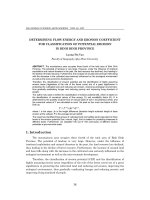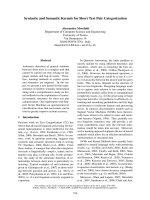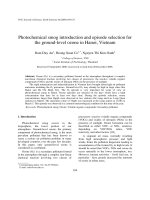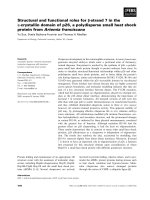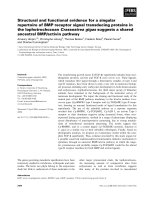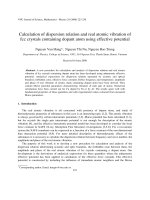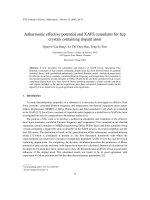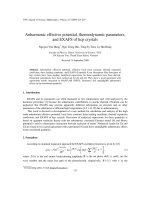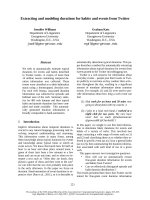Báo cáo " Anharmonic effective potential and XAFS cumulants for hcp crystals containing dopant atom " potx
Bạn đang xem bản rút gọn của tài liệu. Xem và tải ngay bản đầy đủ của tài liệu tại đây (121.99 KB, 7 trang )
VNU Journal of Science, Mathematics - Physics 23 (2007) 28-34
28
Anharmonic effective potential and XAFS cumulants for hcp
crystals containing dopant atom
Nguyen Van Hung
*
, Le Thi Thuy Hau, Tong Sy Tien
Department of Physics, College of Science, VNU
334 Nguyen Trai, Hanoi, Vietnam
Received 17 June 2007
Abstract. A new procedure for calculation and analysis of XAFS (X-ray Absorption Fine
Structure) cumulants of hcp crystals containing dopant atom has been derived based on quantum
statistical theory with generalized anharmonic correlated Einstein model. Analytical expressions
for effective local force constants, correlated Einstein frequency and temperature, first cumulant or
net thermal expansion, second cumulant or Debye Waller factor and third cumulant of hcp crystals
containing dopant atom have been derived. Morse potential parameters of pure crystals and those
with dopant included in the derived expressions have been calculated. Numerical results for Zn
doped by Cd are found to be in good agreement with experiment.
1.
Introduction
To study thermodynamic properties of a substance it is necessary to investigate its effective local
force constants, correlated Einstein frequency and temperature, net thermal expansion, mean square
relative displacement (MSRD) or Debye Waller factor and third cumulant [1-14] which are contained
in the XAFS [12]. Local force constants of transition metal dopants in a nickel host in XAFS has been
investigated but only for comparision to Mossbauer studies [10].
The purpose of this work is to develop a method for calculation and evaluation of the effective
local force constants, correlated Einstein frequency and temperature, first cumulant or net thermal
expansion, second cumulant or MSRD characterizing Debye Waller factor and third cumulant of hcp
crystals containing a dopant (D) atom as absorber in the XAFS process. Its nearest neighbors are the
host (H) atoms. The derivation is based on the generalization of the anharmonic correlated Einstein
model [7] which is considered at present as “the best theoretical framework with which the
experimentalist can relate force constants to temperature dependent XAFS” [10] to the case for crystal
containing dopant atom. For completing the ab initio calculation procedure the parameters of Morse
potential of pure crystals and those with dopant have been also calculated. Numerical calculations for
Zn doped by Cd atom have been carried out to show the thermodynamical effects of hcp crystal under
influence of the doping atom. The calculated results are found to be in good agreement with
experiment for Morse potential and for the other thermodynamic parameters [13].
______
* Corresponding author. Tel: 84-4-8587425
E-mail:
Nguyen Van Hung et al. / VNU Journal of Science, Mathematics - Physics 23 (2007) 28-34
29
2.
Formalism
The expression for the MSRD in XAFS theory is derived based on the anharmonic correlated
Einstein model [7] generalized to the case with a dopant atom according to which the effective
interaction Einstein potential of the system consisting of an dopant (D) atom as absorber and the other
host (H) atoms as scatterers is given by
( ) ( )
( ) ( )
2 3
3 12
1 µ
2
κ 4 κ
2
1 1 1
4 κ 4 4
2 2 2 2 2 2
eff eff HD HD ij
i
HD HD HD
HD HH HH HH
j i
ˆ ˆ
V x k x k x V x V x .
M
x
V x V x V
x x x
V V . V . V x .
≠
≅ + + = +
= + − +
+ − + + − + −
∑
R R
(1)
HD
H
HD
HD
MM
M
MM
MM
+
=
+
=
κµ
,
. (2)
Here
x
is deviation between the instantaneous bond length
r
and its equilibrium value
r
o
,
eff
k
is
effective local force constant, and
3
k
the cubic parameter giving an asymmetry in the pair distribution
function,
R
ˆ
is bond unit vector. The correlated Einstein model is here generalized as a oscillation of a
pair of atoms with masses
D
M
and
H
M
(e.g., of dopant atom as absorber and of host atom as
backscatterer) in a given system. Their oscillation is influenced by their neighbors given by the 2
nd
term in the right side of the second of Eq. (1), where the sum
i
is over absorber (
1
=
i
) and
backscatterer (
2
=
i
), and the sum
j
is over all their nearest neighbors, excluding the absorber and
backsctterer themselves. The latter contributions are described by the term
( )
HD
V x
. The third equality
is for hcp crystals containing dopant atom.
For weak anharmonicity in XAFS the Morse potential is used expanded to the 3
rd
order
(
)
(
)
2α α 2 2 3 3
2 1 α α
x x
V( x ) D e e D x x
− −
= − ≅ − + − +
(3)
for the pure material and
(
)
+−+−=
32
32
1)( xxDxV
HDHDHDHD
αα
(4)
for the doping case, where Morse potential parameters have been obtained by averaging those of the
pure materials and they are given by
HD
HHDD
HD
HD
HHDD
HD
HD
HD
DD
DD
DD
DDDD
D
+
+
=
+
+
=
+
=
33
3
22
2
,,
2
αα
α
αα
α
. (5)
Using the definition [2, 7]
a
x
y
−
=
as the deviation from the equilibrium value of
x
the Eq. (1) is
rewritten in the sum of the harmonic contribution and the anharmonic contribution
V
δ
as a
purturbation
( )
VykyV
effeff
δ
+=
2
2
1
. (6)
Taking into account the atomic distribution of hcp crystal and using the above equations we obtain
the effective local force constant
2222
4
3
)31(2
EHHHDHDeff
DDk
µωαακ
=
++= , (7)
Nguyen Van Hung et al. / VNU Journal of Science, Mathematics - Physics 23 (2007) 28-34
30
the cubic anharmonic parameter
( )
3 3 2
3
1
1
κ α α
8
HD HD H H
k D D
= − − −
, (8)
the anharmonic contribution to the effective potential of the system
(
)
(
)
3333222
8
1
1
4
3
312)( yDDayDDyV
HHHDHDHHHDHD
−−−
++=
αακαακδ
, (9)
the correlated Einstein frequency and temperature
BEEeffE
kk /,/
ωθµω
==
(10)
The cumulants have been derived by averaging procedure in quantum statistics, using the
statistical density matrix
ρ
and the canonical partition function Z in the form
,3,2,1,)(
1
=>=< myTr
Z
y
mm
ρ
, (11)
ooo
TrZZTrZ
ρ
δρ
ρ
ρ
ρ
=
≈
+
=
=
,,
, (12)
Tkyk
P
He
Beffo
H
o
o
/1,
2
1
2
,
2
2
=+==
−
β
µ
ρ
β
, (13)
where
B
k
is Boltzmann constant and
δρ
is neglected due to small anharmonicity in XAFS [2].
Using the above results we calculate the second cumulant or Debye-Waller factor
(
)
T
eff
E
n
n
oo
EE
ez
z
z
k
nyne
Z
yTr
Z
/
222
,
1
1
2
11
θω
ω
ρσ
−−
=
−
+
==≈
∑
, (14)
where we express
y
in terms of anihilation and creation operators,
a
ˆ
and
+
a
ˆ
, i. e.,
(
)
E
aaaay
µω
2
;
ˆˆ
2
00
=+=
+
(15)
and use harmonic oscillator state n with eigenvalue
En
nE
ω
=
(ignoring the zero point energy for
convenience).
Therefore, the expression for second cumulant (MSRD) or Debye-Waller factor is resulted as
++
=
+
=
222
222
4
3
)31(4
,
z)-(1
z)(1
HHHDHD
E
oo
DD
αακ
ω
σσσ
. (16)
Now we calculate the odd cumulants
( )
nynnVn
EE
ee
Z
y
m
nn
nn
EE
mm
nn
''
1
'.
'0
'
δσ
β
β
∑
−
−
==
−
−
. (17)
Using the calculated matrix elements and mathematical formulas for different transformations we
obtain the expressions for the first cumulant (
m=
1)
( ) ( ) ( )
(
)
2
222
233
11231
4
3
)31(8
8
1
13
,
1
1
3
)(
++
−−
=
−
+
=−==
HHHDHD
EHHHDHD
oo
eff
DD
DD
z
z
k
k
Ta
αακ
ωαακ
σσσσ
, (18)
Nguyen Van Hung et al. / VNU Journal of Science, Mathematics - Physics 23 (2007) 28-34
31
and for the third cumulant (
m=3
)
( )
2
2
3)3(
)1(
)101(
z
zz
o
−
++
=
σσ
;
( )
(
)
3
222
233
2
3
4
3
)31(
8
1
1
16
)(
++
−−
=
HHHDHD
HHHDHD
E
o
DD
DD
αακ
αακ
ω
σ
. (19)
From Eq. (18) we obtain the thermal expansion coefficient
( )
( )
( )
3 3 2
2
0 0
2 2
2 2 2
1
3 1 κ α α
1
8
α α α
3
1
4 1 3κ α α
4
B HD HD H H
T T T
HD HD H H
k D D
z ln z
da
,
r dT
z
r ( )D D
− −
= = =
−
+ +
. (20)
In the above expressions
(
)
(
)
1 3
2
σ σ σ
o o o
, ,
are zero-point contributions to the first, second and third
cumulants, respectively. They characterize quantum effects occurred by using quantum theory in our
calculation and influence on the obtained results,
0
T
α
is constant value which
T
α
approaches at high
temperatures. The above derived values are contained in the XAFS including anharmonic
contributions [7, 12]. If the doping atom is taken out from the host material all the above expressions
will be changed into those of the pure hcp crystals [14].
3.
Numerical results and comparison to experiment
Now we apply the above derived expressions to numerical calculations for Zn doped by
Cd atom
as absorber in the XAFS process. Their Morse potential parameters have been calculated using the
procedure presented in [15, 16]. The Calculated values of Morse potential parameters; correlated
Einstein frequency and temperature; effective local force constant for the pure Zn, Cd
and those for Zn
doped by Cd
atom are written in Table I. They agree well with experiment [13].
Table 1. Calculated Morse potential parameters D,
α
;Einstein frequency
E
ω
and temperature
E
θ
; effective
local force constant
eff
k
for Zn-Zn, Cd-Cd, Zn-Cd compared to experiment [13].
Bond
D(eV)
α
(Å
-1
)
r
o
(Å)
(
)
mNk
eff
/
)10(
13
Hz
E
×
ω
(
)
K
E
θ
Zn-Zn, present 0.1698 1.7054 2.7931 39.5616 2.6917 205.6101
Zn-Zn, exp.[13] 0.1685 1.7000 2.7650 39.0105 2.6729 204.1730
Cd-Cd, present 0.1675 1.9069 3.0419 48.7927 2.2798 174.1425
Cd-Cd, exp.[13] 0.1653 1.9053 3.0550 48.0711 2.2628 172.8499
Zn-Cd, present 0.1687 1.8084 2.9175 36.7083 2.3057 176.1268
Zn-Cd, exp.[13] 0.1669 1.8046 2.9100 36.1851 2.2893 174.8673
Figure 1 illustrates our calculated Morse potential (
a
) and anharmonic effective potential (
b
) for
Zn doped by Cd atom. The Morse potential for this case has the same form as for the pure material, the
anharmonic effective potential becomes asymmetric due to the third order of the potential. All they
agree well with experiment [13].
Nguyen Van Hung et al. / VNU Journal of Science, Mathematics - Physics 23 (2007) 28-34
32
a) b)
Figure 1.
Calculated Morse potential (a) and anharmonic effective potential (b) for Zn doped by Cd atom
compared to experiment [13].
Figure 2 demonstrates the calculated first cumulant or net thermal expansion
(
)
(
)
1
σ
T
(a), and
second cumulant or Debye-Waller factor
(
)
2
σ
T
(b). The third cumulant
(
)
(
)
3
σ
T
and cumulant relation
(
)
(
)
321
/
σσσ
, which is oft studied in XAFS, are inllustrated in Figure 3 showing a good agreement
with experiment [13] at 77K and 300K. In this doping material the relation
(
)
(
)
321
/
σσσ
descreases
fastly from the value 1.5 at 0K and then approaches a constant value ½ at high temperatures as for the
hcp pure crystals [14] and for the other crystal structures such as fcc [7]. Hence, this cumulant relation
is an important standard characteristic in XAFS technique not only for the pure crystals but also for
the doping materials. Moreover, our calculated cumulants satisfy all their fundamental properties [17],
i. e., they contain zero-point contributions due to quantum effects at low temperatures, the 1
st
and 2
nd
cumulants are linearly proportional to the temperature and the 3
rd
one to the square of temperature at
high temperatures. They agree well with experiment at 77K and 300K [13].
a) b)
Figure 2. Temperature dependence of our calculated 1st
(
)
(
)
1
σ
T
(a) and 2nd (b)
(
)
(
)
2
σ
T
cumulant for Zn doped
by Cd compared to experiment at 77K and 300K [13].
Nguyen Van Hung et al. / VNU Journal of Science, Mathematics - Physics 23 (2007) 28-34
33
a) b)
Figure 3. Calculated second cumulant
(
)
(
)
2
σ
T
(a) and cumulant relation (b) for Zn doped by Cd compared to
experiment at 77K and 300K [13].
4.
Conclusions
A new analytical method for calculation and evaluation of the thermodynamic properties of hcp
crystals containing dopant atom has been developed based on the quantum statistical theory with the
anharmonic correlated Einstein model generalized for the doping hcp crystal.
The derived expressions for the local effective force constants, anharmonic effective potential,
correlated Einstein frequency and temperature, the first, second and third XAFS cumulant of hcp
crystals containing dopant atom satisfy all standard properties of these quantities. The cumulant
relation
(
)
(
)
321
/
σσσ
, which is oft studied in XAFS technique, for doping materials also has the same
properties as for the pure crystals with different structures.
The calculated Morse potential for the doping material has the same form as for the pure one, the
anharmonic effective potential becomes asymmetric due to the anharmonicity.
The good agreement between the calculated and the experimental results demonstrates the
efficiency and possibility of using the present developed procedure in XAFS data analysis.
Acknowledgments. This work is supported in part by the basic science research national program
provided by the Ministry of Science and Technology No. 40.58.06.
References
[1] E.A. Stern, P. Livins, Z. Zhang, Phys. Rev. B 43 (1991) 8550.
[2] A.I. Frankel, J.J. Rehr, Phys. Rev. B 48 (1993) 585.
[3] T. Miyanaga, T. Fujikawa, J. Phys. Soc. Jpn. 63 (1994) 1036 and 3683.
[4] N.V. Hung, R. Frahm, Physica B 208-209 (1995) 91.
[5] N.V. Hung, R. Frahm, H. Kamitsubo, J. Phys. Soc. Jpn. 65 (1996) 3571.
[6] N.V. Hung, J. de Physique IV (1997) C2 : 279.
[7] N.V. Hung, J.J. Rehr, Phys. Rev. B 56 (1997) 43.
Nguyen Van Hung et al. / VNU Journal of Science, Mathematics - Physics 23 (2007) 28-34
34
[8] N.V. Hung, Commun. Phys. 8 (1998) 46-54.
[9] N.V. Hung, N.B. Duc, R. Frahm, J. Phys. Soc. Jpn. 72 (2003) 1254.
[10] M. Daniel, D.M. Pease, N.V. Hung, J.I. Budnick, Phys. Rev. B 69 (2004) 134414.
[11] N.V. Hung, Paolo Fornasini, J. Phys. Soc. Jpn. 76 (2007) 084601.
[12] See X-ray absorption, edited by D.C. Koningsberger and R. Prins (Wiley, New York, 1988).
[13] R.R. Frahm, N.V. Hung (to be published).
[14] N.V. Hung et al. (to be published).
[15] L.A. Girifalco, V.G. Weizer, Phys. Rev. 114 (1959) 687.
[16] N.V. Hung, D.X. Viet, VNU Journal of Science 19 N
0
2 (2003) 19.
[17] J.M. Ziman, Principles of the Theory of Solids, 2
nd
ed. by Cambridge University Press, 1972.
